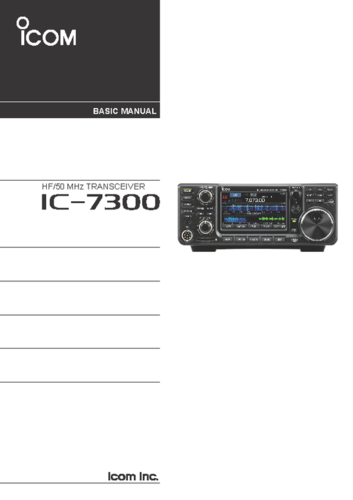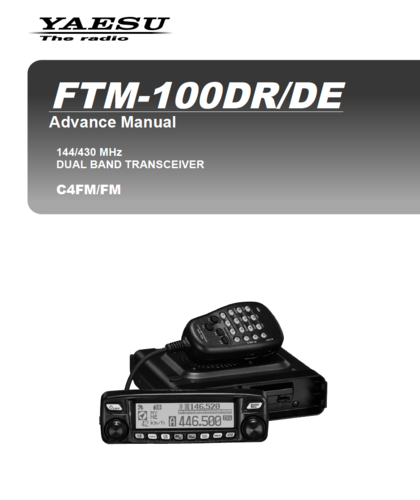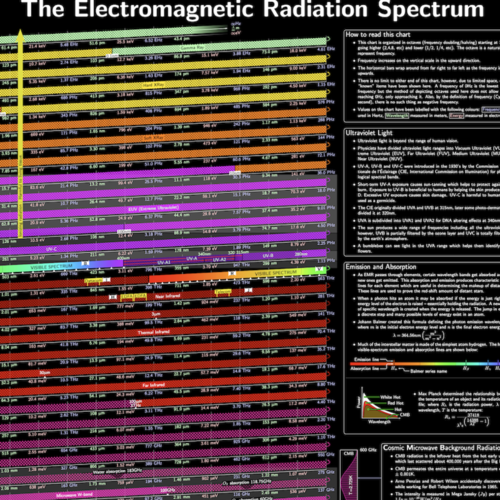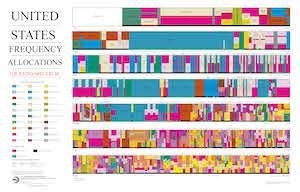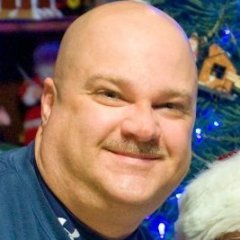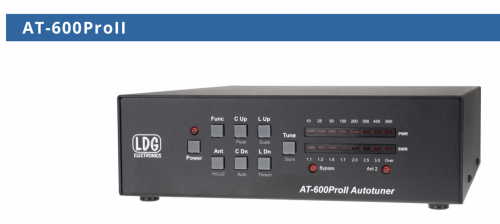
The LDG AT-600ProII is a general purpose automatic tuner intended for use with midsize amplifiers with up to 600 watts output on SSB or CW from 1.8 – 54 MHz.
Like most LDG tuners the AT-600ProII operates automatically, beginning a tuning cycle whenever the SWR exceeds a preset limit. To protect its circuitry it will not tune at power levels above 150 watts; bypass your amplifier (or place it in Standby) to complete a tuning cycle using only the exciter. The AT-600ProII also features LDG’s advanced memory tuning, providing 2,000 memory locations; when tuning near a previously used frequency it will recall the settings for nearly instant tuning. It learns your favorite frequencies and bands as you use it. You can also start a tuning cycle manually whenever necessary.
The AT-600ProII has a large, easy to read bar-graph wattmeter that show forward and reverse power with two selectable ranges (60 and 600 watts), as well as an SWR meter. The AT-600ProII will interface with many popular transceivers so you can start a tuning cycle with the radio’s TUNE button. Dedicated control buttons on the tuner allow you to fine-tune capacitance and inductance on those rare occasions when the AT-600ProII can’t find a perfect match by itself.
The AT-600ProII features two output connectors so you can easily switch between two antennas. There are 2,000 memory locations for each antenna, allowing nearly instant returning on frequencies you’ve used before.
The AT-600ProII will tune from 1.8 to 54.0 MHz continuously, and will match Yagis, dipoles, inverted-Vs, slopers, or virtually any coax-fed antenna from 6 to 1000 ohms impedance (16 – 150 ohms on 6 meters). Tuning time is usually under 10 seconds; memory tuning time is under 0.2 seconds. Longwires or antennas fed with ladder line require an external balun, not included.
All LDG tuners come with a two year fully transferable warranty, and LDG’s legendary customer service. Contact your LDG dealer to order.
HF/50 SDR transceiver with Touch Screen and Band Scope
Yaesu FTM-100DR Advanced manual
Uniquely designed Electromagnetic Radiation Spectrum chart going from Ultra Low Frequency to Gamma Rays.
Link to the author's website: http://unihedron.com/projects/spectrum/moreinfo.php
Additional content here: http://unihedron.com/index.php

The new K4 doesn’t just harness the latest technology: it blends new tech with a classic user interface to create a transceiver that’s more than the sum of its parts. One that’s sophisticated, yet civilized.
Like you, we’ve witnessed the recent revolution in direct sampling and SDRs. But rather than rush toward change, we’ve been observing — saving the best ideas, testing them, and quietly merging them into a new kind of radio. The resulting modular, hybrid design is innovative and versatile, yet still a pleasure to use.
In particular, operators who’ve used our K3S transceiver and P3 panadapter will find the K4’s controls familiar, and its complement of I/O compatible with their existing station. But they’ll also discover a new level of convenience in the bright, 7” touch display, which combines a large panadapter with three intuitive multi-function controls. Everything you need is at your fingertips, including a unique built-in help system.
Three K4 Flavors
There are three K4 models to choose from: the basic K4; the K4D, which adds diversity receive capability; and the K4HD, which goes a step beyond other direct-sampling SDRs, adding a dual superhet module for the ultimate in blocking and close-in dynamic range.
A basic K4 can be easily upgraded to a K4D at any time by adding the KDIV4 option.
Similarly, a K4D can be upgraded to a K4HD by adding the KHDR4.
The K4 and K4D, like other “pure” direct-sampling radios, do not require crystal roofing filters. Digital signal processing is used to provide advanced demodulation, filtering, and signal display. The K4HD can operate either in direct-sampling or superhet mode. Typically the latter is only needed in the presence of extreme signals.
Modularity that Adapts to Your Needs
Flexibility — now and in the future — was a major design goal for the K4. All of Elecraft’s transceivers embody this philosophy. You can tailor the radio to your current needs, with one of the three models described above as well as other options. But you’ll also be ready to take advantage of new technology that in some cases hasn’t even been invented. Modules are segmented strategically to allow updates at a moderate cost so you won’t have to invest in a new radio every couple of years. Elecraft also listens to its community: the best ideas often translate into new options and software features.
Advanced Remote Control, Host Interfacing, and Display
With the K4, you can operate at the radio itself or from anywhere — whether it’s your living room, back porch, or halfway around the world. One K4 can control another, including streaming panadapter display. you can also use a tablet, netbook, or desktop PC. When operating the radio directly, you can use both the built-in LCD and an external monitor (HDMI), with different content.
Application programmers will benefit from the K4’s rich, yet easy to use command set, including many new commands for setting up panadapter and audio streams.
Society's increasing use of radio-based technologies, and the opportunities for development that these technologies provide, highlight the importance of the radio spectrum. The spectrum is used for all forms of wireless communication including: cellular telephone, radio and television broadcasting, GPS position locating, aeronautical and maritime radio navigation, and satellite command and control. Technological progress has continually opened doors to a variety of new radio applications that have spurred interest in, and demand for spectrum. The amount of available spectrum is a fixed resource. Increased demand requires that the radio spectrum be used efficiently and this means that effective spectrum management processes must be implemented. Spectrum management is the oversight of radio frequency spectrum use. The goal is to prevent users from harmful interference while allowing optimum use of the spectrum. There are four phases of spectrum management:




